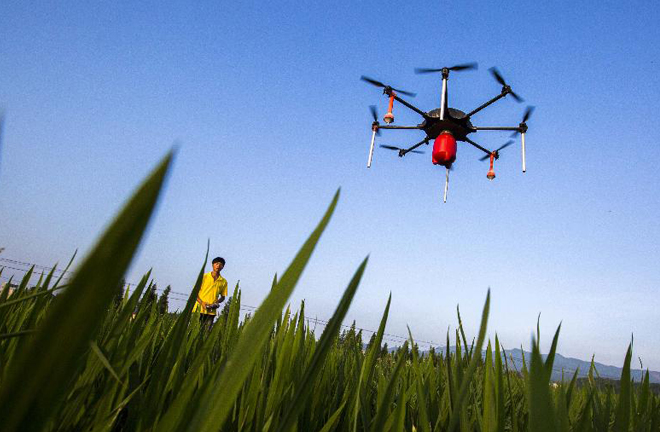Structural reform to further develop China’s agriculture

A worker operates a drone which sprays insecticide on crops on July. 2, 2016 at Shanfengcun Village in Jiujiang City of central China’s Jiangxi Province.
China wrapped up a two-day Central Rural Work Conference on Dec. 20, underscoring the importance of deepening supply-side structural reform in agriculture and improving the quality as well as efficiency of agricultural supply chains.
Coordinating development among food crops, cash crops and forage crops, transforming production-oriented agriculture to being consumption-oriented and increasing the supply of green, ecological and organic products to satisfy the needs of residents in urban and rural areas should be promoted on the premise of guaranteeing basic self-supply of cereals and safety of food grains, said Zuo Ting, a professor from the College of Humanities and Development Studies at the China Agricultural University.
Li Guoxiang, a research fellow from the Rural Development Institute at the Chinese Academy of Social Sciences, said the key to agricultural supply-side structural reform is to transform agricultural production modes, adding that the extensive agriculture should be transformed and the pricing mechanisms for agricultural products should be reformed by coordinating the “two hands” of government and the market.
Agricultural structure dynamically evolves over time to adjust to economic growth and people’s living standards, said Ma Hua, a professor from the China Urban-Rural Development Institute at Shanxi University.
Supply-side structural reform in agriculture should fully liberalize its factors of production, and the government should motivate farmers by utilizing market forces. The government should also extend the industrial chain of agriculture and expand agricultural functions, Ma added.
The financing and investment systems of agriculture are among the key issues of the reform, and a string of measures could be carried out, including broadening fiscal financing channels, attracting social and financial capital, and combining the fiscal input and development of agriculture industry with increasing the income of farmers, Li said.
Zuo pointed out that system reform and mechanism innovation should be considered as fundamental approaches to optimize the industrial system, productive system and business system in agriculture, in a bid to raise the land output rate, utilization rate of natural resources and labor productivity.
The design of agricultural policy at this stage should not only ensure the stability of agricultural prices, but also guarantee the basic income of farmers. The policy should be designed to tackle the problems that farmers sometimes encounter in selling their crops. It should also be designed to let the market determine the prices of agricultural products and separate subsidies from pricing mechanisms. It should also put forth a new type of agricultural insurance mechanism that covers natural disasters and risks of price change in market, Zuo added.
Ma said that green development is a basic requirement of agricultural supply-side structural reform and also the key trend of modern agriculture. Therefore, food safety, environmental protection, sustainable resource use as well as harmonious development between human and nature should be set as priorities, he said.
ZHANG FAN is a reporter at the Chinese Social Sciences Today.
